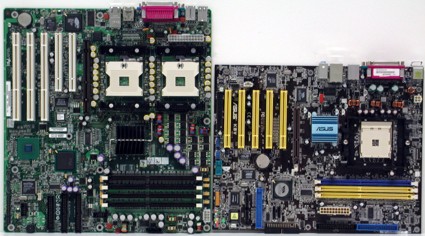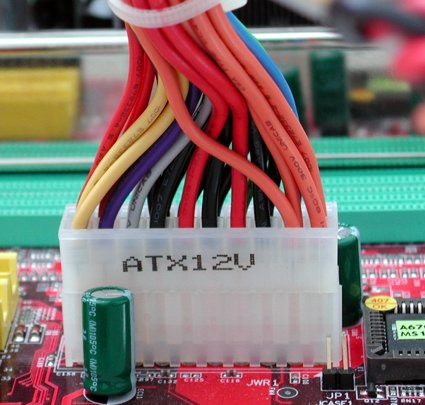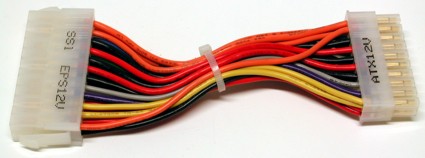Two Xeon CPUs Are Better Than One Intel P4 Extreme Platform
The Right Motherboard Format: ATX Or WTX
On the left, the big WTX format and on the right, the ATX format
Compared to standard ATX boards, Xeon workstation boards have considerably more units, including, for example, PCI64/X interfaces, two Southbridges, LAN chips, voltage regulators, CPU socket or an additional SCSI controller. In order to accommodate the higher number of components, larger boards in WTX standard are required. These have a 32.94% larger surface area, measuring 33 x 33.5 cm compared to the ATX boards (30.5 x 24.5 cm). Boards with a WTX form factor do not fit in a conventional home PC case. The manufacturers MSI and Tyan also offer motherboards without the additional components, such as P64H2 Bridge and LAN in an ATX format. At any rate, installing them in a conventional tower would not be a problem.
The Right Power Adapter: ATX Or EPS12V
Fully stocked Xeon system
Because we are talking here about a dual CPU platform, the processing unit's power loss is also doubled. The fastest Xeon models with a Prestonia 2-M core and 3.2 GHz speed have, as a pair, a maximum power loss of 184 watts. Added to that are board components (an average of 50 watts), a high-performance graphics card with 70 watts, and a large memory upgrade - all together, it quickly uses up 350 watts.
A 20-pole plug provides a motherboard with voltage
This overloads the power supply to the motherboard. As a result, the boards in WTX format have another power adapter standard, which goes by the name of EPS12V. They have connections with more power and mass cores, as well as wider plugs in order to distribute the load better. As with the ATX form factor, the power pins are also made of gold in order to attain a lower resistance and to therefore improve the quality of the signals.
A voltage adapter from a Tagan power adapter (TG480-U01)
Get Tom's Hardware's best news and in-depth reviews, straight to your inbox.
Current page: The Right Motherboard Format: ATX Or WTX
Prev Page Dual Xeon Double Offer Next Page The Right Power Adapter: ATX Or EPS12V, ContinuedTom's Hardware is the leading destination for hardcore computer enthusiasts. We cover everything from processors to 3D printers, single-board computers, SSDs and high-end gaming rigs, empowering readers to make the most of the tech they love, keep up on the latest developments and buy the right gear. Our staff has more than 100 years of combined experience covering news, solving tech problems and reviewing components and systems.




